NC National Parks Information
North Carolina has 14 National Parks, Sites, Heritage Cultures or Trails located in several different locations across the state. No matter where you travel in North Carolina there is a National Park, Site or Trail close by for you to explore and enjoy. The North Carolina National Parks can be: educational; provide fun sports activities like hiking or kiteboarding; provide camping; provide beautiful scenery and overlooks like on the Blue Ridge Parkway, the Great Smoky Mountains, or the Outer Banks; offer opportunities to view wildlife plants and animals in their natural habitat; and so much more.North Carolina National Parks are there for the enjoyment of all. Plan a trip today to visit one or visit them all!
North Carolina National Parks by Region
Mountain Region
Great Smoky Mountains National Park – It is the most visited national park in the United States with over 9 million visitors annually.The mountains that form the Great Smoky Mountains straddles the borders of the two states North Carolina and Tennessee. The Cherokee used the word Shacorage meaning “blue, like smoke” to describe the mountain region. It is approximately 521,895 acres in size and has up to 100,000 different types of plants and animals that call the Great Smoky Mountain National Park home. Mountain elevations in the park range from just over 875 feet to 6,643 feet. The tallest elevation point is at the popular tourist site of Clingmans Dome.
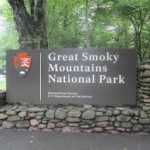
Blue Ridge Parkway – The Blue Ridge Parkway is a scenic highway that winds along the Appalachian Mountains. It stretches from Virginia in the Shenandoah National Park through the NC mountains to the south entrance of The Great Smoky Mountain in Cherokee, NC. Blue Ridge Parkway is a National Parkway with breath taking mountain views. A 469 mile long scenic highway mostly along the Blue Ridge Mountains in North Carolina. Its a 2 lane highway with a speed limit of 45 miles per hour specifically set for site seeing. It is closed to commercial traffic.
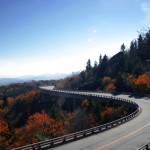
Blue Ridge National Heritage Area – The North Carolina mountains and foothills were designated the Blue Ridge National Heritage Area.The area is a federally designated National Heritage Area and it covers the 25 counties located in Western North Carolina. Explore the heritage and history of the: Agricultural Heritage; Music Heritage, Cherokee Heritage; Craft Heritage; Natural Heritage; and Historic Blue Ridge. The Blue Ridge National Heritage Area was established in 2003. Enjoy Blue Ridge towns, communities, sites, events,festivals and so much more. The Blue Ridge area has some of the most beautiful land in the state. The main office of the Blue Ridge National Heritage Area is located at 195 Hemphill Knob Road ( on the Blue Ridge Parkway at Milepost 384) in Asheville, NC.
Appalachian National Scenic Trail -The Appalachian National Scenic Trail is a 2,174-mile cleared trail that winds along the mountains and valleys of the Appalachian Mountains from the Eastern United States of Maine to Georgia. The Appalachian Trail has an estimated length due to the constantly changing trail as parts are modified or rerouted. The North Carolina section of the Appalachian Trail is an estimated 311 miles (88 miles in NC and over 200 miles located on the NC/TN boarder). Most of the NC portion of the The Appalachian Trail actually is located on the state boarder of NC and Tennessee. After the AT passes Fontana Lake the trail heads south into North Carolina through the Nantahala National Forest and continues south into Georgia. Altitude ranges in North Carolina are from 1,725 to 5,498 feet.The Appalachian Trail is marked by 2″ by 6″ white paint blazes that identify the trail’s pathway.
Carl Sandburg Home National Historic Site – Carl Sandburg, famous writer, poet, and biographer died in 1967. His wife decided to honor his legacy by allowing his home to be preserved. The Carl Sandburg Home National Historic Site is a 264 acre area that is open to the public for touring. Visitors can tour the home, hike on trails in the park, enjoy the farm including the farm animals, and visit the bookstore.Open daily except holidays.Touring the house is a guided tour only with purchase of a ticket needed.The Carl Sandburg Home National Historic Site is located at 1928 Little River Road in the village of Flat Rock, North Carolina which is near Hendersonville, NC.
Overmountain Victory National Historic Trail – The Overmountain Victory National Historic Trail is part of the U.S. National Trails System. The trails goes through VA, TN, NC and SC and is 330 miles long, part of which is located in North Carolina. The Overmountain Victory National Historic Trail retraces the route of Revolutionary War Overmountain Men patriot militia who crossed the Great Smoky Mountains and went on to fight in the Battle of Kings Mountain in South Carolina.The Overmountain Victory National Historic Trail includes sections of a walking pathway, a Commemorative Motor Route that is 70 miles long, affiliated historic sites and museums, and exhibits. The Commemorative Motor Route is open 24/7/325 weather permitting.The walking pathway is open dawn to dusk, year-round, weather permitting.
Trail of Tears National Historic Trail – In the year 1838, the US government forced out of their homelands the Cherokee Indian people. The Cherokee were forced to march to Indian Territory (now the state of Oklahoma). Hundreds of the Cherokee people died during the march and at the relocation site. The trail used on the march is now referred to as The Trail of Tears. The Trail of Tears commemorate the survival of the Cherokee people and passes through the present-day states of Alabama, Arkansas, Georgia, Illinois, Kentucky, Missouri, North Carolina, Oklahoma, and Tennessee.
Central NC Region
Guilford Courthouse National Military Park – The Guilford Courthouse National Military Park is located in Greensboro, NC. It commemorates the Battle of Guilford Court House which was took place on March 15, 1781 during the Revolutionary War. The battle was the beginning of the strategy that led to the American victory. The number of British troops losses were so great the battle was a reason to their surrender at Yorktown later that year. The battlefield is preserved as a National Military Park. The park library has information on the almost 4500 American soldiers who fought in the battle. Located in the park is the Green Monument, erected in 1915, in honor of Major General Nathanael Greene, the leader of the American troops in the battle. The city of Greensboro was named after him. The park has a Battlefield Visitor Center, Tour Road and Tour Road comfort station, exhibits and 28 monuements
that honor the Revolutionary soldiers, statesmen, heroes, and heroines of the battle.The park is located at 2332 New Garden Road, Greensboro, NC.
Coastal Region
Cape Hatteras National Seashore – The Cape Hatteras National Seashore is located at the North Carolina Outer Banks and is over 70 miles longs. It extends from Bodie Island to Ocracoke Island. It was the first national seashore established by the Federal Government. The national seashore preserves the barrier islands that form the outer boundaries of NC. The islands are constantly changing due to the forces of nature from wind, ocean waves, storms, ocean tides and hurricanes. Cape Hatteras National Seashore provides a coastal environment to explore and enjoy. The beauty of the NC barrier islands are breathtaking. The Cape Hatteras Lighthouse is located within the CHNS in Buxton, NC on Hatteras Island. The national seashore has day areas, camping, and beach accesses to be enjoyed by thousands of visitors each year.
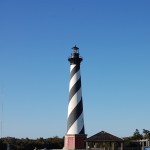
Cape Lookout National Seashore – Cape Lookout Lighthouse is part of the Crystal Coast and is located in the Cape Lookout National Seashore. The lighthouse and island can be reached only by private boat or boat taxi. It is a three mile boat ride off-shore to get to the barrier islands of Cape Lookout National Seashore. There you can explore the historic villages, climb the lighthouse, go shelling or fishing and enjoy the remote island setting. Must take your own supply of water, food and mosquito repellent is a must.
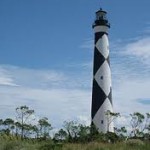
Fort Raleigh National Historic Site – commemorates and preserves the first English attempt to settle the New World. Visitors learn of the history and hardships the colony faced while attempting to establish the colony. Trails wind around the historic grounds past a restored earthen fort that represents the original fort. A nature trail that is ¼ mile long meanders thru the shaded grounds with small woodland animals scurrying about the brush and trees. Conveniently placed shaded picnic tables sit under large trees and are located near the office and exhibit buildings. In spring and summer make sure to check out the huge scuppernong grape vine near the parking lot.
Wright Brothers National Memorial -The site the Wright Brothers
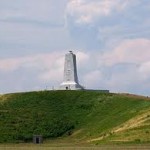
performed glider tests and later flying a plane from the sand dune named Kill Devil Hill on December 17, 1903. This is the site of four powered flights the Wright Brothers accomplished one windy blustery day. The memorial has a visitors center, a bookstore, exhibits including a full-scale replica of the 1902 glider and the 1903 airplane. The grounds also include replica buildings of living quarters and the hangar the Wright Brothers used during their stay on the Outer Banks. The 60-foot granite monument sits on top of the 90-foot dune Kill Devil Hill.
Gullah Geechee Cultural Heritage Corridor – The Gullah Geechee Cultural Heritage Corridor stretches from Wilmington, NC to South Carolina, Georgia and into Florida. The culture orginated from various ethnic groups of west and central Africa. The Gullah/Geechee people are descendents of enslaved Africans that were brought to the southern United States and made to work on the plantations of the southern coastal states. Gullah/Geechee people have retained many aspects of their African heritage due to the geographic barriers of the coastal landscape. The descendants in these communities have held on to many customs, vocabulary and crafts, such as their naming traditions, patterns of speech and African vocabulary, worldviews, philosophy, African religious syncretism, ring-shouts, sweetgrass basket weaving, mortar & pestle use, diet and cooking methods, carving traditions, fishing methods (net making and casting), quilting pattens (African symbolism), rice cultivation, and storytelling traditions. Gullah/Geechee descendants settled in the coastal counties of North Carolina (Brunswick County and New Hanover County), South Carolina, Georgia, and Florida. It is one of America’s most unique cultures. The Gullah Geechee Cultural Heritage Corridor was created in 2006 to recognize the important contributions made to the American culture and history by the Africans and African Americans known as Gullah/Geechee. The National Park Service does not own or manage
the land but has the responsibility to provide assistance to National Heritage Areas.
Moores Creek National Battlefield – The Battle of Moores Creek Bridge took place during the American Revolutionary War on February 27, 1776. The battle was fought near Wilmington, North Carolina. The battle was between North Carolina Patriot and the Loyalist militia forces. Almost 1000 North Carolina Patriots waited across the bridge as the Loyalist crossed the bridge advancing
toward the NC Patriots. The Loyalist, surprised by the attack suffered many dead or wounded men during the battle. Moores Creek Battlefield is the site of the first Patriot victory in the American Revoluntionary War. The park has two interpretive trails totaling one mile in length. There is a Visitors Center, Bookstore, and covered picnic shelters in the park. Moores Creek Bridge is located near Wilmington but in a rural area. Each Year on the last full weekend of February there are activities to celebrate the anniversary, including musket and cannon demonstrations, militia encampments, living history demonstrations, live music, and more. Their annual Candlelight Tours are scheduled for Friday
and Saturday, November 14 & 15, 2014 from 6:00 pm-9:00 pm. Go back in time to 1776 and live the history!
1000 N croatan hwy, Kill Devil Hills, NC 27948
40 Patriots Hall Drive, Currie, NC 28435
2332 New Garden Road, Greensboro, NC 27410
Gatlinburg, TN 37738
131 Charles Street, Harkers Island, NC 28531
Avon, NC 27915
Vinton, VA 24179
